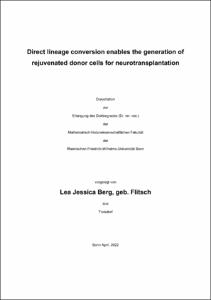Direct lineage conversion enables the generation of rejuvenated donor cells for neurotransplantation

Direct lineage conversion enables the generation of rejuvenated donor cells for neurotransplantation

| dc.contributor.advisor | Brüstle, Oliver | |
| dc.contributor.author | Berg, Lea Jessica | |
| dc.date.accessioned | 2022-12-01T14:05:35Z | |
| dc.date.available | 2023-12-01T23:00:21Z | |
| dc.date.issued | 01.12.2022 | |
| dc.identifier.uri | https://hdl.handle.net/20.500.11811/10492 | |
| dc.description.abstract | With the advent of cell programming, several strategies for disease modeling and cell replacement have become available. While directly converted somatic cell-derived induced neurons largely preserve age-associated traits, induced pluripotent stem cells (iPSCs) and their derivatives represent an embryonic-like stage. Here, we investigated whether age-related cellular properties are also conserved upon direct conversion of adult human peripheral blood cells into induced neural stem cells (iNSCs). Specifically, employing Sendai virus (SeV)-mediated overexpression of the two transcription factors SOX2 and cMYC, we generated a bona fide NSC population from erythroid progenitor cells. Despite the lack of a pluripotency transit, we found that even iNSCs converted from >85-year-old donors display a remarkable degree of epigenetic rejuvenation and lack age-associated cellular hallmarks similar to iPSC-derived NSCs. We next characterized the dynamics underlying DNA methylation age changes induced by iNSC conversion in greater detail, revealing that the process of epigenetic rejuvenation is protracted in this conversion paradigm and most likely independent of stem cell proliferation. This could make iNSC conversion a blueprint for somatic cell rejuvenation and a promising alternative for the derivation of neural cells for regenerative applications. Therefore, we next confirmed that iNSCs survive neurotransplantation in neonatal and adult mice, generating electrophysiologically active neurons as well as glial cells upon engraftment. Most importantly, iNSC-derived neurons exhibit transplantation site-appropriate efferent projection patterns and undergo synaptic integration into the host brain as suggested by human NCAM-based fiber tracking and pseudotyped Rabies virus-based monosynaptic tracing, respectively. Finally, we aimed to explore whether this direct conversion approach could, in principle, be extended to microglia, the immune cells of the central nervous system. Due to the highly restricted access to primary human microglia, we employed iPSC-derived microglia-like cells (iPSdMiG) to address this question. Within two weeks after infection of directly harvested or CD11b-sorted iPSdMiG with temperature-sensitive SeVs, colonies consisting of neuroepithelial-like-shaped cells emerged, and the derived cells expressed characteristic NSC markers. As for blood-derived iNSCs, temporary cultivation at 39 °C yielded transgene-free cell lines, which could be further proliferated for multiple passages and gave rise to functional neurons, astrocytes and oligodendrocytes upon differentiation. Considering their epigenetically rejuvenated state, their amenability to in vivo application and the fact that they can be generated from different somatic cell types, directly converted iNSCs provide interesting prospects for disease-related research and neuroregeneration. | en |
| dc.language.iso | eng | |
| dc.rights | In Copyright | |
| dc.rights.uri | http://rightsstatements.org/vocab/InC/1.0/ | |
| dc.subject | Zellprogrammierung | |
| dc.subject | Direkte Konversion | |
| dc.subject | Zelluläres altern | |
| dc.subject | Transplantation | |
| dc.subject | Neuroregeneration | |
| dc.subject | Cell programming | |
| dc.subject | Direct conversion | |
| dc.subject | Cellular aging | |
| dc.subject.ddc | 570 Biowissenschaften, Biologie | |
| dc.title | Direct lineage conversion enables the generation of rejuvenated donor cells for neurotransplantation | |
| dc.type | Dissertation oder Habilitation | |
| dc.publisher.name | Universitäts- und Landesbibliothek Bonn | |
| dc.publisher.location | Bonn | |
| dc.rights.accessRights | openAccess | |
| dc.identifier.urn | https://nbn-resolving.org/urn:nbn:de:hbz:5-68461 | |
| ulbbn.pubtype | Erstveröffentlichung | |
| ulbbn.birthname | Flitsch | |
| ulbbnediss.affiliation.name | Rheinische Friedrich-Wilhelms-Universität Bonn | |
| ulbbnediss.affiliation.location | Bonn | |
| ulbbnediss.thesis.level | Dissertation | |
| ulbbnediss.dissID | 6846 | |
| ulbbnediss.date.accepted | 14.10.2022 | |
| ulbbnediss.institute | Medizinische Fakultät / Institute : Institut für Rekonstruktive Neurobiologie (IRN) | |
| ulbbnediss.fakultaet | Mathematisch-Naturwissenschaftliche Fakultät | |
| dc.contributor.coReferee | Kolanus, Waldemar | |
| ulbbnediss.contributor.orcid | https://orcid.org/0000-0002-2746-6519 | |
| ulbbnediss.date.embargoEndDate | 01.12.2023 |
Files in this item
This item appears in the following Collection(s)
-
E-Dissertationen (4337)




